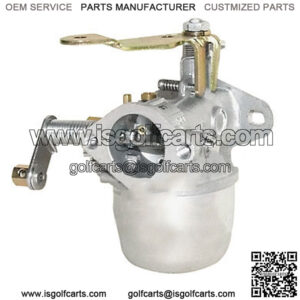Adjusting the Air and Fuel Mixture
1
Locate the air filter and remove it. On most cars, you’ll need to remove the air filter to expose to carburetor and adjust it. Open the hood and make sure the engine is off before locating the air filter and removing the assembly. Unscrew the wing-nut and any other connectors, and then remove the air filter entirely.[1]
- Depending on your make and model, and the kind of engine in the vehicle, the air filter could be in any number of different places on the engine. Consult the owner’s manual or the shop guide for your vehicle.
- On most carbureted cars, the air cleaner housing is attached directly to the carburetor.
2
Find the adjustment screws on the front of the carburetor. There should be two screws on the front of the carburetor, which are used to adjust the air and fuel mixture.[2]
- Often these look like flat-head screws and you can use a screwdriver to turn them, adjusting the amount of fuel and air mixing in the carb.
- Some carburetors, such as the Quadrajet found in most GM vehicles, have a special screw and require a specific adjusting tool. The Quadrajet uses a Double “D” carburetor adjusting tool.
- Other carburetors may have a 4 corner idle mix adjustment (4 idle mixture screws).
3
Start the engine and let it warm to normal operating temperature. Check the temperature gauge to know when it’s at the appropriate running temp, and listen to the sound of the engine to get some sense of the adjustments that need to be made.[3]
- An engine that runs lean will ping at higher RPM, when the throttle is open, as if you were flooding a gear. More gas needs added to the mixture.
- An engine that runs rich won’t necessarily make a change in sound, but you’ll be able to smell it. Bring the gas down some. An engine that runs too rich at idle will cause the plugs to be fuel-fouled, leading to a vehicle that is harder to start cold.
4
Adjust both screws equally and find the right mixture. Adjusting the carburetor is a lot like tuning a guitar or other stringed instrument. You want to turn the screws equally, smoothly, and slowly until you find the sweet spot. Regardless of whether or not the engine is running too rich or too lean, bring it down to a very lean mixture by turning both screws a quarter-turn at a time, counter-clockwise, then slowly bringing them back up to an equal and smooth mixture.[4]
- Adjusting the mixture is an imprecise art, requiring that you know your engine well and listen close. Bring both screws up slowly and listen until the engine purrs smoothly. Any raggedness or rattling is a sign of too lean a mixture. Keep turning until you find the sweet spot.
- Use a scanner to check the air-fuel mixture of the vehicle to help you get the right adjustment.[5]
5
Replace the air filter assembly. When you’ve got the carb adjusted, put the air filter back on and you’re ready to roll.
Method2
Adjusting the Idle Speed
1
Find the idle adjustment screw. There is an idle speed screw that adjust the opening of the throttle plate, and an idle mixture screw that limits the flow of fuel at idle. You want to adjust this second screw. As always, consult the owner’s manual or shop guide for your make and model, if you can’t find the screws.[6]
2
Start the engine and let it warm to running temperature. Just as you did with the fuel/air mixture, let the engine warm up some to make sure you’re adjusting at actual running condition.
3
Turn the idle adjustment screw to tighten. Turn the screw clockwise, no more than a half-turn, and listen to the engine. Most owner’s manuals will have an optimum speed to set the idle, though you have some wiggle room if you prefer it higher or lower. Consult you owner’s manual for the number and consult the tachometer as you adjust.[7]
4
Listen to the car’s engine for sounds of roughness and readjust if necessary. It should take about 30 seconds for the engine to adjust to the change you made, so don’t get happy fingers and over-adjust. Make slow turns and listen closely to the response.
5
Replace the air filter and finish the job. When you’ve got the idle adjusted to the proper specifications, or to your own preferences, kill the engine and replace the air filter to finish the job.

